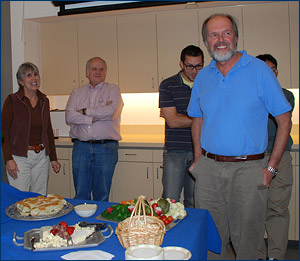
Roy Caldwell (right foreground) is caught off guard when he walks into a surprise party arranged in his honor. At left are Associate Director Judy Scotchmoor and Professor Dave Lindberg. Dave was Director before Roy.
Letters from the Directors
Letter from the outgoing Director
Like any typical eight-year-old taxonomist, I quickly learned the names and shapes of my hoard of models, but I was eager to know more. How big were they really? What did they eat? Were there dinosaurs today? The tags that came with the plastic models listed only their names, and the Cedar Rapids bookstores were not exactly overflowing with material on dinosaurs. My Christmas stocking that year contained A Little Golden Book, Dinosaurs. The cover featured the obligate erupting volcano and a green and pink sauropod galloping away from a T. rex bearing a toothy grin. I read and reread the book from cover to cover until the gold binding tape cracked. Still, each question answered fueled another how or why. I talked my mother into taking me to the library (our first trip) where surely they had "better" books on dinosaurs. With pride we checked out Edwin H. Colbert's The Dinosaur Book and I couldn't wait to explore its secrets. That evening after the mandatory listening to "The Lone Ranger," I started to read. As I remember it, the text was dull and the pencil drawings duller. In hindsight, perhaps I was in a bit over my head, but I didn't finish chapter one and two weeks later the book was returned to the library shelf from whence it came. So ended my tryst with dinosaurs. I'm not sure what happened to all of my precious figures, but I vaguely remember having the Brachiosaurus in the sights of my .22 a couple of years later.
So why the plod down memory lane other than to reveal that I'm old and know very little about dinosaurs? Last month I stepped down after serving for five years as Director of the UCMP, arguably one of the great paleontology museums in the world. I have always felt it more than a bit ironic that I would head such an institution with no more formal training and background in paleontology other than that provided by a shoebox full of plastic dinosaur figurines.
But things might have been different … what if I had hung in there a couple of more years and had checked out a new copy of Roy Chapman Andrews' All About Dinosaurs? What if the trip to the toy store had revealed the dizzying assortment of books, puppets, games and figures available today? What if I had been able to log onto one of UCMP's websites?
Curiosity in a child (or adult) is a wondrous, but fragile trait that can shape how we view the world. It can be turned on and nurtured with interesting, appropriate material just as easily as it can be extinguished. UCMP is not a public exhibits museum, but we have many ways through which we can reach, inform, and excite the public, and we do a really good job at doing just that. Our public outreach and education contributions, showcased by our presence on the web, are some of the best in the world. We reach hundreds of grade school students through our participation in the GK-12 program and the tours ably conducted by our graduate students (I never tired of pushing my way into the office through all those eager and illuminated little faces). Our science is second to none, and it is disseminated with flare and pride reaching an incredibly broad audience. I guess the message I want to leave you with is "Don't stop!" We are purveyors of wonder as well as knowledge — you never know when you might kindle a spark in a curious eight-year-old, igniting a lifelong love of science. Who knows, had I encountered UCMP when I was drooling over my shoebox of plastic dinosaurs, I might have actually become a real paleontologist.
Roy Caldwell
P.S. — I do have ~35 stomatopod fossils!
Letter from the incoming Director
 Charles Marshall |
Beyond the campus, I look forward to interacting with the depth of paleontological talent in the region, including at the California Academy of Sciences, UC Davis, UC Santa Cruz, San Jose State, Cal State University East Bay, and Stanford and finding ways that UCMP can support the teaching of paleontology both formally and informally at institutions within the greater Bay Area.
I would also like to take this opportunity to thank the outgoing Director, Roy Caldwell, for his outstanding management of the UCMP at a time of intense financial pressure, and for his assistance in helping my transition into UCMP. His extraordinary skill has left us with the capacity to replace at least one of the two invertebrate positions left fallow by Jere and Carole's retirement, and so we can expect to grow a little even in these hard times.
The coming years will be both exciting and challenging as we deal with uncertain financial times, even as we adapt to the recent and future cuts in state funds and a yet undetermined loss of endowment. On my agenda, beyond promoting the research, curriculum development, the maintenance and growth of the collections, and the education and outreach missions of the Museum, will be fund-raising so that these core components of the Museum can operate at the highest level in the years to come. I so appreciate all the friends of UCMP who have helped, and continue to help, the museum in all of its varied missions.
I look forward to getting to know you all, and working with you to make an even stronger and better UCMP.
Sincerely,
Charles Marshall
Director, UCMP
Photos by Jennifer Skene